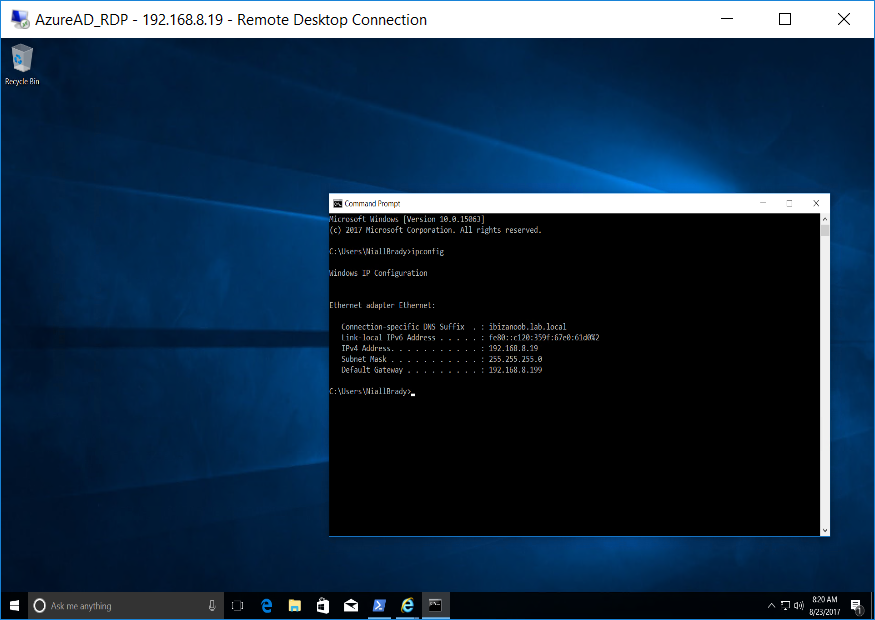March 15, 2016 Tech Notes Azure 1 Comment on Remote Desktop for Linux VM on Azure Usually you don’t need remote desktop or VNC on Linux servers running in the cloud. But as I wanted to try some scenarios with a Linux desktop and I actually don’t have a physical machine loaded with any Linux OS, I ended up setting up a Ubuntu server on Azure. Next, head to Remmina on your remote computer, enter the IP address of the Linux desktop you want to connect with, select VNC as the protocol, and hit the Enter key. Remmina12vncprotocol.png If you previously chose the authentication option New connections must ask for access, the RHEL system's user will see a prompt like this.
For details, see Enable remote desktop for Linux virtual machines. Connect to the student VM using SSH When a student signs in to the Labs portal directly ( ) or by using a registration link ( ), a tile for each lab the student has access to is displayed.
Some days ago Chris Pietschmann wrote about How to Setup an Ubuntu Linux VM in Azure with Remote Desktop (RDP) Access(great job certainly), and in a little ping pong messages I ask about how to enable another Desktop GUI that be more “attractive” to the users (GNOME or Ubuntu Desktop)… Chris said that he tried with Ubuntu desktop, but something goes wrong with xRDP (the server for RDP for X Window)… and the challenge was born!… and here we are…
First that all… I want to recognize that I didn’t reinvent the wheel… I just put some pieces of the puzzle together :0).
I’ll to obviate the explanation about the support for RDP in Linux and the process to create an Ubuntu VM in Azure, for more detail go to the blog entry mentioned above…
When you get your Ubuntu VM up and running… connect via ssh (I use the Ubuntu bash in my Windows 10…) and do the next:
First you need to install Unity Desktop GUI (obviously):
- To install Unity run the next commands in your terminal session:
- sudo apt-get update
- sudo apt-get update
- Restart the VM by the Azure portal

You can see that the Unity Desktop is installed by using Boot diagnostics in the Azure portal
Linux Remote Desktop To Windows
The next task that we need to do is to install and configure xRDP

- Create a Downloads folder under your home directory, and go to there:
- mkdir Downloads
- cd Downloads
- mkdir Downloads
- Download the next zip file (that contains the script to install and configure xRDP for Unity Interface).. I’ll give credits to Griffon who’s wrote the original one install-xrdp-1.9.1.zip
- wget -O /home/terminator/Downloads https://tym1zq.bn.files.1drv.com/y4mWThEWEC0iKojSq34rQCdsw4GdG0dkbpLTLPMHJRT6AXndOq1f8rZ2VvTAi2g9lpg3CFrHKnG9XcF5FXPeR9FdOjdg9Oyvu8BIlxY4xXLR1HsI-1vRM4SIGr5Ik39gzKceZL3fqgROkVn3aMmYZEQI6xrFfVLYyMfC-RvBFjYGxLCNp8BpuqRu_LFVsVfAdi-/install-xrdp-1.9.1.zip
- sudo apt-get install unzip
- unzip install-xrdp-1.9.1.zip
- chmod +x ~/Downloads/install-xrdp-1.9.1.sh
The last image resumes the previous steps…
And execute that! :O) (you can go to take a coffee in the while…)
- sudo ./install-xrdp-1.9.1.sh
… when the process ends (and you have tasted your coffee…) test the connection… is I posted in a Tweet reply to @BuildAzure if you use the Windows RDP client (mstsc.exe) the performance get slow… but if you use another one (for example FreeRDP) the connection works fine… according to some post in some blogs the issue is with the RemoteFX feature (in the client side)…
- chmod +x ~/Downloads/install-xrdp-1.9.1.sh
Azure Linux Vm Remote Desktop
Azure Linux Remote Desktop
That’s all folks!
